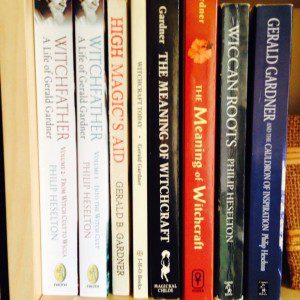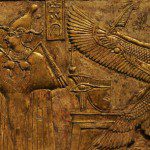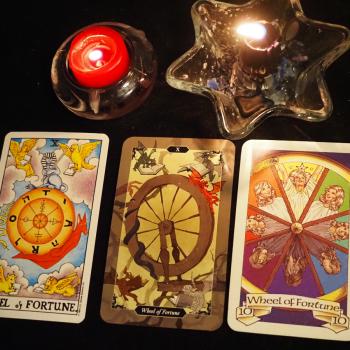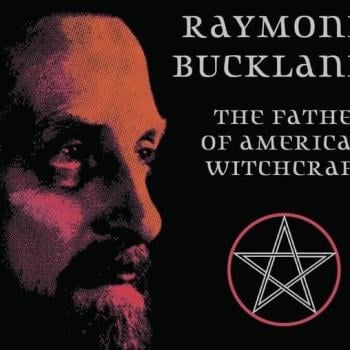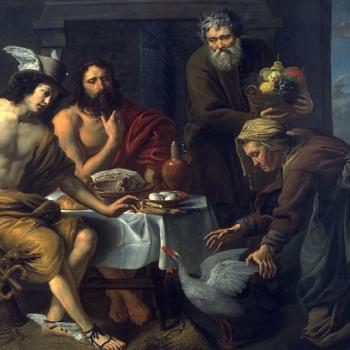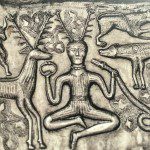The importance of Gerald Gardner (1884-1964) to Modern Witchcraft and Modern Paganism cannot be overstated. Gardner was one of the first people in the Twentieth Century to publicly self-identify as a Witch, and he either created, revealed, or refined the first long lasting and influential tradition within Modern Paganism. The origins of Gardner’s Craft might be in dispute, but there’s no disputing his passion for it. Once he went public as a Witch in the early 50’s he worked tirelessly to promote the Witch Religion, and we should all be glad that he did. I’m sure Modern Paganism would still exist without Gardner’s contribution, but it would be a different, and most likely smaller movement.
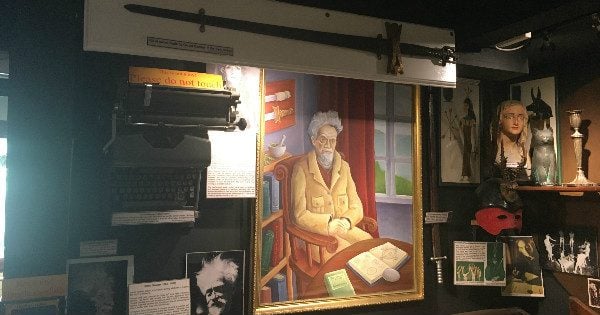
Fifty years after his death Gardner’s shadow still looms large. Anyone who has ever cast a circle, called to the four quarters and invoked the gods has been influenced by Gardner. While many of Gardner’s ideas about the occult (and to some extent Witchcraft in general) are no longer fashionable his influence as a ritualist remains strong. I’ve said it before and I’ll say it again, Gardner’s magickal system (even in its myriad of adapted forms) simply works. Even the witchcrafts which may have preceded it were later influenced by it.
For all of his influence Gardner didn’t leave much of a written legacy. During his lifetime he wrote only five books, two fictional, two about Witchcraft, and one about the Malaysian kris (a type of knife). There’s not much outside of Gardner’s own writings either. As one of the seminal figures in Modern Paganism one would think that Gardner would be the subject of multiple biographies and analysis, sadly that’s not the case. So far only a small handful of academics and historians have taken up the challenge that is Gardner. Hopefully that will change over the next couple of decades.
More In The Witch’s Guide Series:
Dion Fortune
Doreen Valiente
Aleister Crowley
Robert Cochrane
His Own Words
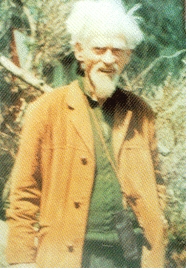 The best place to start with Gardner is with his own writings. Unlike an Aleister Crowley, all of Gardner’s works are easy to read and don’t require a graduate degree in esotericism to understand. With that being said, Gardner’s books on Witchcraft are mostly a convoluted mess. There’s a lot going on in Witchcraft Today and The Meaning of Witchcraft, and not all of it really pertains to Witchcraft.
The best place to start with Gardner is with his own writings. Unlike an Aleister Crowley, all of Gardner’s works are easy to read and don’t require a graduate degree in esotericism to understand. With that being said, Gardner’s books on Witchcraft are mostly a convoluted mess. There’s a lot going on in Witchcraft Today and The Meaning of Witchcraft, and not all of it really pertains to Witchcraft.
Gardner takes everything magickal and/or mysterious in world history and links them to his understanding of Witchcraft. What emerges is a garbled history touching on everything from the Knights Templar to races of pygmies living in ancient Europe. The history in Gardner’s books is mostly bad, but he wasn’t trying to spread disinformation. His writing represents an awful lot of things that people believed in during the 1950’s. I like to look at Gardner’s writings about Witchcraft as a journey into the mind of an early 20th Century Witch and Occultist. Not all of it’s true, but all of it’s fascinating.
The best parts of Meaning and Today are when Gardner sets aside his regurgitating of Margaret Murray and focuses on the bits and pieces of actual Witch Practice. The Myth of Witchcraft which Gardner included in Witchcraft Today (1954) remains especially striking:
Now G.* had never loved, but she would solve all mysteries, even the mystery of Death, and so she journeyed to the nether lands. The guardians of the portals challenged her. ‘Strip off thy garments, lay aside thy jewels, for nought may ye bring with you into this our land.’ So she laid down her garments
and her jewels and was bound as are all who enter the realms of Death, the mighty one.Such was her beauty that Death himself knelt and kissed her feet, saying: “Blessed be thy feet that have brought thee in these ways. Abide with me, but let me place my cold hand on thy heart.” And she replied: “I love thee not. Why doest thou cause all things that I love and take delight in to fade and die?” “Lady,” replied Death, “tis age and fate, against which I am helpless. Age causes all things to wither; but when men die at the end of time, I give them rest and peace and strength so that they may return. But you, you are lovely. Return not; abide with me.” But she answered: “I love thee not.” Then said Death: “As you receive not my hand on your heart, you must receive Death’s scourge.” “It is fate, better so,” she said, and she knelt. Death scourged her and she cried: “I know the pangs of love.” And Death said: “Blessed be,” and gave her the fivefold kiss, saying: “Thus only may you attain to joy and knowledge.”
And he taught her all the mysteries, and they loved and were one; and he taught her all the magic’s. For there are three great events in the life of man – love, death and resurrection in the new body – and magic controls them all. To fulfill love you must return again at the same time and place as the loved ones, and you must remember and love her or him again. But to be reborn you must die and be ready for a new body; to die you must be born; without love you may not be born, and this is all the magic.”
*G. represents the retracted name of a goddess.
It’s a gorgeous tale, and the language used by Death and G. is beautiful, strikingly different from everything else in Witchcraft Today. If Gardner’s magickal system was still in flux when he wrote this back in 1953/54 you’d never know it from this passage. The Five Fold Kiss, the words “Blessed Be,” even the bits of theology sound sure-footed and developed. It’s the bits like this that give Gardner’s published works real meaning.
In my opinion the most enjoyable of Gardner’s books is High Magic’s Aid (1949), a fictional tale set in the 12th Century. According to Gardner his initiating High Priestess was reluctant to allow him to release a non-fiction book detailing the “Witch Cult,” but she did allow him to create a fictionalized account of their Witchcraft, Aid was the result. The workings in the book are mostly taken from The Key of Solomon, but the rituals still feel familiar none the less. It was High Magic’s Aid that Gardner generally handed to people interested in his version of Witchcraft, which speaks volumes as to how highly Gardner thought of the book. It’s a bit more readable than Gardner’s non-fiction works, most likely the result of Madelaine Montalban who typed up Gardner’s story and perhaps added a little bit of polish to it.
Biography
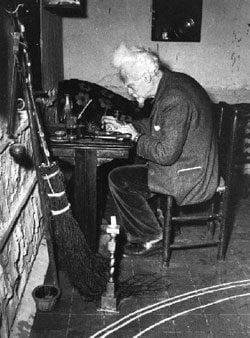 Before he passed away in 1964 Gardner was the subject of one biography: Gerald Gardner: Witch attributed to Jack Bracelin (an initiate of Gardner’s) but actually written by Idries Shah, a Sufi Priest with an interest in Gardner’s Witchcraft. Bracelin’s/Shah’s Gardner biography was sanctioned by Gardner, and like most “authorized” biographies highly suspect as to the details. However there are some great moments in Witch, many of them dealing with the build-up to Gardner’s initiation as a Witch in 1939.
Before he passed away in 1964 Gardner was the subject of one biography: Gerald Gardner: Witch attributed to Jack Bracelin (an initiate of Gardner’s) but actually written by Idries Shah, a Sufi Priest with an interest in Gardner’s Witchcraft. Bracelin’s/Shah’s Gardner biography was sanctioned by Gardner, and like most “authorized” biographies highly suspect as to the details. However there are some great moments in Witch, many of them dealing with the build-up to Gardner’s initiation as a Witch in 1939.
That initiation in 1939 is a matter of disagreement amongst Gardner’s later biographers. Two of them (Ronald Hutton and Aiden Kelly) believe that Gardner’s claim of initiation in 1939 is unlikely. On the other side of the argument is Philip Heselton who makes a very strong case that Gerald Gardner was initiated into something back in those days leading up to World War II. I think reading and understanding both sides of the argument is important when dealing with The Grand Old Man of Witchcraft.
It’s important to remember that historians are taught to rely on what they can actually see. If there’s no paper-trail or smoking gun the conservative approach is what academia suggests. For a Hutton or Kelly to argue against Gardner being initiated in 1939 is not surprising, and doesn’t do anything to diminish the legacy of Gardner and those who have been influenced by his writing, his tradition, and his teachings.
Despite arguing against the likelihood of Gardner being initiated into an established tradition, I think Ronald Hutton’s portrayal of Gerald Gardner in Triumph of the Moon is a positive one. Gardner comes across as a likable fellow, and not the sexual deviant his detractors attempt to portray him as. If Gardner created the way of “the Wica” at least Hutton portrays Gardner as a passionate individual completely dedicated to his beliefs. Triumph of the Moon (1999) is not a book about Gardner, but Gardner’s contribution to Modern Witchcraft is so large that he takes up a great deal of it. At one point Hutton describes Gardner as a “nexus,” implying that all of the forces that helped to shape Modern Witchcraft were taken up and synthesized by Gardner, who then shared them with the world.
I’d be happy with Gardner simply as a “nexus,” but I’m a firm believer that he was initiated into something back in 1939. Was that something hundreds of years old? In my opinion probably not, but I think it pre-dated Gardner’s involvement, most likely by a few decades. The case for Gardner’s initiation has been most articulately expressed in the works of Philip Heselton. I’m of the opinion that Heselton’s works are critical, but sadly, two of those works (Gerald Gardner And the Cauldron of Inspiration: An Investigation into the Sources of Gardnerian Witchcraft from 2003 and Wiccan Roots: Gerald Gardner and the Modern Witchcraft Revival from 2001) are difficult to acquire in the United States*. Luckily for us Heselton’s two-volume life of Gerald Gardner, Witchfather (2012) is still in print (and available as an e-book) and contains much of the same information. (Witchfather is available in two volumes, Into the Witch Cult and From Witch Cult to Wicca.)
Heselton makes a great case for Gardner being initiated by looking at the magickal and occult figures living in the area of New Forest England around Gardner back in 1939. Were there enough folks there to have created a Witch Religion from various sources? Yup, and with sources to spare. New Forest was apparently crawling with cunning-folk (who by extension could make Gardner’s Craft centuries old indeed), Co-Masons, Rosicrucians, and former members of the Golden Dawn. Since Heselton is not an academic he’s also able to take a few “leaps of faith” here and there, throwing out speculation and conjecture without a care in the world. Heselton doesn’t necessarily prove anything but he does create a plausible scenario.
For true-Gardner nerds I also recommend the website Gerald Gardner dot com. It’s chock-full of fascinating information about Gardner’s life, works, and inspirations. It’s a truly valuable resource and has been a great help to me over the years.
Despite what many think, Gardner’s complete ritual/magickal system remains an oath-bound secret. Bits of Gardner’s writings ritual have been shared and leaked over the years, and some of Gardner’s original work has been touched up/refined by writers such as Doreen Valiente, but the entire tradition remains mostly under lock and key. Even with that being the case it’s still possible to work very much in the spirit of Gardner and other early British Witches thanks to a few ritual books.
The most complete of those books are from Janet and Stewart Farrar, with A Witches Bible (its self a collected version of their earlier What Witches Do and Eight Sabbats for Witches) being my favorite. It’s a pretty complete look at British Witchcraft from the ritual side of things, with the second half of the book sharing a great deal of “belief” though not so much any theological underpinnings. It’s not Gardnerian Witchcraft, but it’s Witchcraft in the style of Gardner. In a similar vein are the works of Lady Sheba (including The Grimoire of Lady Sheba), but Sheba completely lacks any real explanation as to what her rituals are trying to express.
There are also lots of works out there masquerading as “Gardner’s Book of Shadows.” Many of them do contain some early writings of Gardner, but those writings are not from his BoS, they come from an early workbook known as Ye Booke of Ye Art Magical. Ye Booke is interesting, but it is not Gardnerian Witchcraft. Ye Booke contains some fascinating ritual experiments, but it’s a long way from the tradition that bears Gerald’s name today.
The Non-Adept Should Make Sure to Read . . . . :
Triumph of the Moon by Ronald Hutton. Fifteen years after its initial publication Triumph remains the best book written on the origins of Modern Witchcraft.
Witchfather Volumes One and Two by Philip Heselton. With Heselton’s other books difficult to obtain in the United States, Witchfather is the best place to get the other side of the story.
Witchcraft Today or High Magic’s Aid by Gerald Gardner. You probably won’t like either of these two books, but they are extremely important parts of Witch and Pagan history.
A Witches Bible by Janet and Stewart Farrar. British Trad-style Witchcraft has been an important building block in the evolution of Modern Pagan Ritual (whether or not someone identifies as a Wiccan or not). Being familiar with it is well worth your time.
An it harm none, do what ye will . . . . .
*An earlier version of this piece made the erroneous assumption that Wiccan Roots and Cauldron of Inspiration were out of print. They are not out of print, however they are difficult to obtain in the United States. When I initially ordered my copies all those years ago I got them from Amazon UK.


